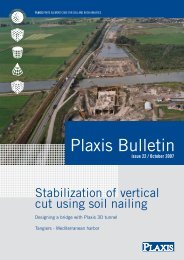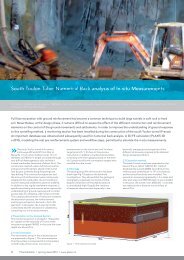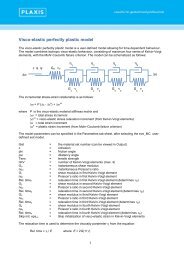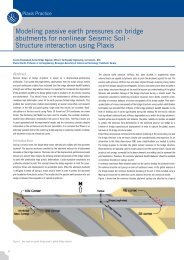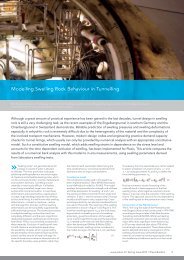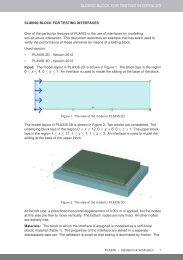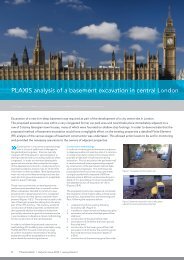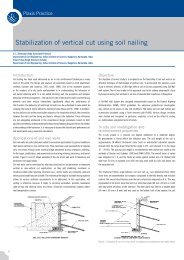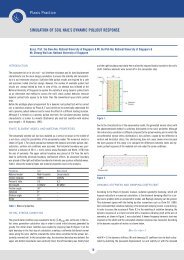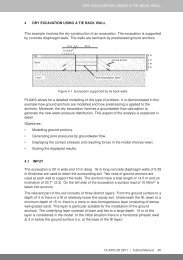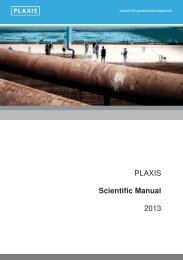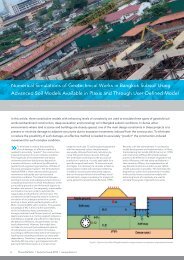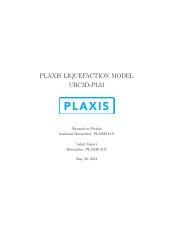You also want an ePaper? Increase the reach of your titles
YUMPU automatically turns print PDFs into web optimized ePapers that Google loves.
New Developments<br />
New Developments<br />
Ronald Brinkgreve<br />
in the previous <strong>Bulletin</strong> information was given about the <strong>Plaxis</strong> 3d developments. it is a<br />
pleasure to mention now that the first general 3d program (<strong>Plaxis</strong>-Gid) has been released.<br />
this program is available as a service to those who feel restricted by the geometrical<br />
limitations of 3d tunnel or 3d foundation. more information can be obtained from the<br />
<strong>Plaxis</strong> sales department.<br />
in this <strong>Bulletin</strong> i like to mention another new development that is currently in progress:<br />
fully coupled fl ow-deformation analysis.<br />
most <strong>Plaxis</strong> users are familiar with the consolidation option in <strong>Plaxis</strong> 2d and 3d. so far,<br />
<strong>Plaxis</strong> has only considered Biot coupled consolidation under saturated conditions, forming<br />
a coupling between deformation and excess pore pressures. this works well for cases with<br />
constant hydraulic conditions, where the time interval or loading rate is such that the<br />
situation is neither fully drained nor fully undrained. for cases with changing hydraulic<br />
conditions, a simplifi ed solution is available by combining the standard <strong>Plaxis</strong> program<br />
with the transient fl ow module Plaxflow. However, if pore pressure is influenced by loading<br />
of (partially) undrained soil as well as changing hydraulic conditions, there is a need for<br />
consolidation based on total pore pressures, i.e. fully coupled flow-deformation analysis.<br />
examples where this type of analyses is required are clay embankments in tidal areas or<br />
excavations with dewatering in medium soft soils.<br />
With the change of consolidation based on excess pore pressure to total pore pressure it<br />
becomes important to consider the phreatic surface and the unsaturated zone above. as a<br />
result of loading or changing hydraulic conditions, ground water flow may occur, and the<br />
position of the phreatic surface may change. soil that has been fully saturated may become<br />
unsaturated or vice versa. Hence, together with the implementation of fully coupled<br />
flow-deformation analysis, there is also need for models that can describe unsaturated<br />
soil behaviour in more detail. first of all, there are the Van Genuchten relationships between<br />
suction, relative permeability and degree of saturation, which are also used in<br />
Plaxflow. secondly, there is the well-known Barcelona Basic model that deals with suction<br />
and swelling in the unsaturated zone. all this is implemented in the <strong>Plaxis</strong> calculation<br />
kernel to complete the fully coupled flow-deformation analysis feature.<br />
these new features will be available in <strong>Plaxis</strong> 2d version 9.1, which is planned for release<br />
mid 2009. When the implementation is ready, we can start beta-testing with a selected<br />
group of users. after implementation in <strong>Plaxis</strong> 2d we will proceed with the implementation<br />
in the 3d calculation kernel. We are confident that the new features will help many users<br />
in analysing their coupled and unsaturated soil problems.<br />
ronald Brinkgreve<br />
<strong>Plaxis</strong> bv<br />
4



